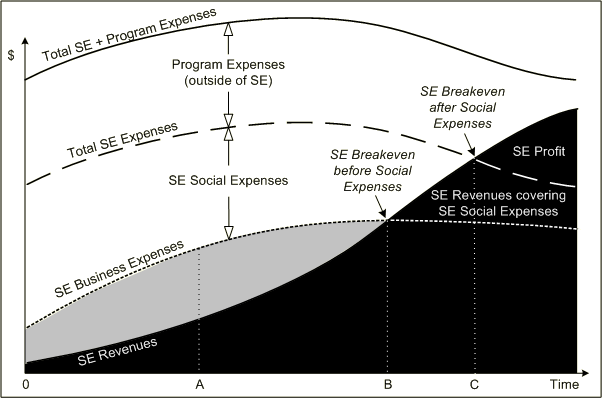External Financing vs. Revenues Over Time
External Financing vs. Revenues Over Time
Legend: SE = Social Enterprise; Y Axis = Money; X Axis = Time;
External Financing = all financing (grants, loans, contributions) minus revenues (internal financing)
Total expenses can be divided into three subcategories (moving upward along the Y-axis):
- SE Business Expenses include all costs found in similar businesses that are strictly for-profit, with no consideration for social impact and mission.
- SE Social Expenses comprise additional expenses incurred because of the social focus of the SE, such as special workplace or benefits requirements. Together, the SE Business Expenses and the SE Social Expenses total the total SE expenses.
- Program Expenses, in this context, represent expenses incurred to support social programs outside the SE.
From Time 0 to Time A (moving along the X-axis), the SE goes through a start-up phase requiring a lot of external financing. Expenses increase faster than revenues. This is a critical phase during which decision-makers must carefully weigh business expenses based on their potential for generating future revenues.
From Time A to Time B, the SE goes through a growth phase during which external financing is still required, but revenues grow at a faster pace than expenses, leading the way to traditional financial sustainability.
The SE reaches its first breakeven point in Time B, at which point the SE becomes sustainable as a traditional business (a business that does not incur additional social expenses). The difference between all Business Expenses and Revenues between Time 0 and Time B represent the total business investment over that period of time (light gray area on the chart). Even the best management team implementing the best business model cannot succeed in bringing a business to that critical point if decision-makers fail to recognize (and budget) the level of external financing that will be required over that certain period of time, both of which can vary greatly based on a variety of factors (all of which are considered during the business planning phase).
From Time B to Time C, the SE still requires external financing, but only to cover part of its Social Expenses (part of which is also covered by SE Revenues). Depending on the model, some social enterprises never grow beyond that point, in which case they serve in a context in which both SE Revenues and external social subsidies can be effectively leveraged to create social impact.
In Time C, the SE might be reaching a second breakeven point, at which all SE expenses are covered by revenues. Additional SE revenues now generate a profit that can fund social programs outside of the SE.